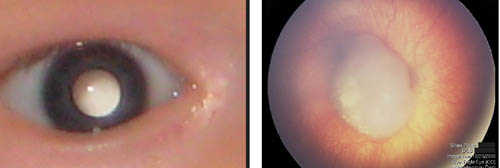 |
|
|
Leukocoria has been assumed to be a sign of advanced
retinoblastoma.
But a new study shows that it can appear in days-old infants. |
Baby pictures are perhaps the best method for early detection of retinoblastoma, a new study found.
“In a majority of retinoblastoma cases, it is the parents that initiate the diagnosis based on seeing leukocoria or ‘white eye’ in photos of their children,” says the study’s lead author Bryan F. Shaw, PhD, who is not an eye researcher but an assistant professor of chemistry and biochemistry at Baylor College.
Dr. Shaw initiated the study after his own son was diagnosed and treated for retinoblastoma.
Researchers already knew that children with retinoblastoma often display persistent leukocoria in photographs. Despite this, digital photography hasn’t been intentionally used to screen for retinoblastoma because “white eye” is assumed to be a symptom of advanced retinoblastoma, not early stage retinoblastoma.
Dr. Shaw’s study dispelled this assumption. It found that leukocoria can be a sign of retinoblastoma in its earliest stages—even in an infant as young as 12 days old, as in the case of Dr. Shaw’s son. Early detection and treatment would increase the chances of survival and reduce loss of vision.
The study, published in the online journal PLoS One, also determined that the brightness and the color saturation of the leukocoria eye can indicate the retinoblastoma’s severity. The brighter the white eye, the larger the tumor, Dr. Shaw says.
The researchers’ next step: “If we can create software that can detect leukocoria and alert a parent when it begins to occur persistently, then I believe digital photography can eradicate metastatic retinoblastoma from this world and prevent most of the deaths that occur,” Dr. Shaw says.
Abdolvahabi A, Taylor BW, Holden RL, et al. Colorimetric and longitudinal analysis of leukocoria in recreational photographs of children with retinoblastoma. PLoS One. 2013 Oct 30;8(10):e76677.

